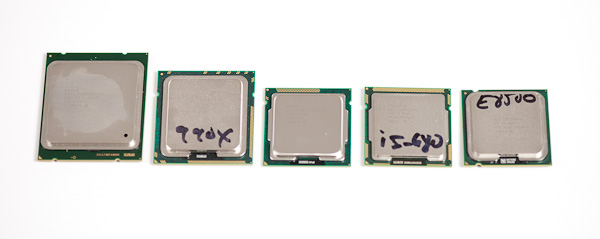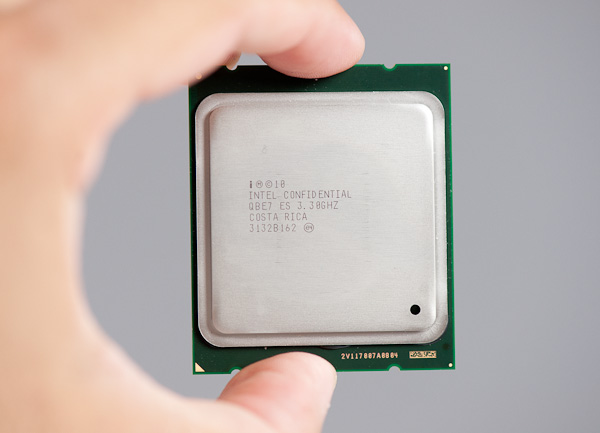Intel Core i7 3960X (Sandy Bridge E) Review: Keeping the High End Alive
by Anand Lal Shimpi on November 14, 2011 3:01 AM EST- Posted in
- CPUs
- Intel
- Core i7
- Sandy Bridge
- Sandy Bridge E
Final Words
There are two aspects of today's launch that bother me: the lack of Quick Sync and the chipset. The former is easy to understand. Sandy Bridge E is supposed to be a no-compromise, ultra high-end desktop solution. The lack of an on-die GPU with Quick Sync support means you have to inherently compromise in adopting the platform. I'm not sure what sort of a solution Intel could've come to (I wouldn't want to give up a pair of cores for a GPU+QuickSync) but I don't like performance/functionality tradeoffs with this class of product. Secondly, while I'm not a SAS user, I would've at least appreciated some more 6Gbps SATA ports on the chipset. Native USB 3.0 support would've been nice as well. Instead what we got was effectively a 6-series chipset with a new name. As Intel's flagship chipset, the X79 falls short.

From left to right: Intel Core i7 (SNB-E), Core i7 (Gulftown), Core i5 (SNB), Core i5 (Clarkdale), Core 2 Duo
LGA-2011, 1366, 1155, 1156, 775
The vast majority of desktop users, even enthusiast-class users, will likely have no need for Sandy Bridge E. The Core i7 3960X may be the world's fastest desktop CPU, but it really requires a heavily threaded workload to prove it. What the 3960X doesn't do is make your gaming experience any better or speed up the majority of desktop applications. The 3960X won't be any slower than the fastest Sandy Bridge CPUs, but it won't be tremendously faster either. The desktop market is clearly well served by Intel's LGA-1155 platform (and its lineage); LGA-2011 is simply a platform for users who need a true powerhouse.
There are no surprises there, we came to the same conclusion when we reviewed Intel's first 6-core CPU last year. If you do happen to have a heavily threaded workload that needs the absolute best performance, the Core i7 3960X can deliver. In our most thread heavy tests the 3960X had no problems outpacing the Core i7 2600K by over 50%. If your livelihood depends on it, the 3960X is worth its entry fee. I suspect for those same workloads, the 3930K will be a good balance of price/performance despite having a smaller L3 cache. I'm not terribly interested in next year's Core i7 3820. Its point is obviously for those users who need the memory bandwidth or PCIe lanes of SNB-E, but don't need more than four cores. I would've liked to have seen a value 6-core offering instead, but I guess with a 435mm2 die size it's a tough sell for Intel management.
Of course compute isn't the only advantage of the Sandy Bridge E platform. With eight DIMM slots on most high end LGA-2011 motherboards you'll be able to throw tons of memory at your system if you need it without having to shop for workstation motherboards with fewer frills.
As for the future of the platform, Intel has already begun talking about Ivy Bridge E. If it follows the pattern set for Ivy Bridge on LGA-1155, IVB-E should be a drop in replacement for LGA-2011 motherboards. The biggest issue there is timing. Ivy will arrive for the mainstream LGA-1155 platforms around the middle of 2012. At earliest, I don't know that we'd see it for LGA-2011 until the end of next year, or perhaps even early 2013 given the late launch of SNB-E. This seems to be the long-term downside to these ultra high-end desktop platforms these days: you end up on a delayed release cadence for each tick/tock on the roadmap. If you've always got to have the latest and greatest, this may prove to be frustrating. Based on what we know of Ivy Bridge however, I suspect that if you're using all six of these cores in SNB-E that you'll wish you had IVB-E sooner, but won't be tempted away from the platform by a quad-core Ivy Bridge on LGA-1155.
I do worry about the long term viability of the ultra high-end desktop platform. As we showed here, some of the gains in threaded apps exceed 50% over a standard Sandy Bridge. That's tangible performance to those who can use it. With the growth in cloud computing it's clear there's demand for these types of chips in servers. I just hope Intel continues to offer a version for desktop users as well.











163 Comments
View All Comments
yankeeDDL - Monday, November 14, 2011 - link
I'm with you xpclient.I will never understand Microsoft's fanboys. Why do they expect the OS to make such huge impact on the benchmarks?
It's like for motherboards: you can differentiate for ease of use, stability, features, supported hardware ... but the benchmarks, will substantially be the same.
XP trails Windows7 on multi core because it was never designed to support so many cores, and MS has no interest in updating it.
Per Hansson - Monday, November 14, 2011 - link
Hi, what resolution and in game graphical settings where used for the World of Warcraft gaming test?It always amazes me how well that game scales with super high-end CPU's, but if it's at just a silly low resolution it does not really matter, so, which is it? (This isn't mentioned in "bench" either....)
Per Hansson - Monday, November 21, 2011 - link
Here is Anand's reply to this question incase anyone cares ;)---
1680 x 1050, 4X AA, all detail settings maxed (except for weather) :)
Take care,
Anand
Mightytonka - Monday, November 14, 2011 - link
Typo on the second page. Should read RST (Rapid Storage Technology), right?Ocire - Monday, November 14, 2011 - link
Nice review! :-)If you want to test PCIe bandwidth, you could use the bandwidth-test that comes with the CUDA SDK. It's easy to setup, and you can also test configurations with multiple GPUs. You should get quite reliable results for pure PCIe Gen.2 performance with that.
It would be really interesting to get some performance numbers for PCIe as that is the bottleneck in quite a few GPU-computing scenarios.
Cheers!
LancerVI - Monday, November 14, 2011 - link
Sounds like a great, enthusiast proc, married to a mainstream chipset at enthusiast prices.That means 'no joy' for me.
I guess I'll be hanging on to my little i7 920 that could for a bit longer. Going on 4 years now. That's unheard of for me!!!
hechacker1 - Monday, November 14, 2011 - link
I'm also going to hang onto the i7 920. Overclocked the x58 platform can still compete with the best of of Sandy Bridge for almost any workload. Sure we're missing some IPC and power enhancements, but nothing worth spending serious cash on.What I'm looking at now is the Gulftown prices. I'm hoping they come down from the $1000 Extreme part, and perhaps we get an affordable 6-core chip for the X58 platform.
I'd be happy to stick with Gulftown until we see affordable 8 core parts, or major IPC improvements.
Makaveli - Monday, November 14, 2011 - link
the 980 non X version is already going for $550This is your next upgrade, as is mine i'm also on a 920.
I doubt that price will drop any lower.
hechacker1 - Monday, November 14, 2011 - link
Yeah I'm going to be watching the prices closely for a while.At $550 for the lowest end Gulftown on newegg, it's still not affordable for me.
It's still cheaper than the intro prices of Sandy Bridge-E including a new motherboard though.
I'll have to watch forums closely for people wanting to sell their chips, I imagine you can snag one used for a good deal.
davideden - Monday, November 14, 2011 - link
I currently have a Core i7 2600K LGA 1155 processor. I am assuming that I won't be able to use this with the new LGA 2011 socket on the new Sandy Bridge E motherboards. Will there be any cheaper processors in the near future that are at the price point of the Core i7 2600K that are compatible? I was disappointed with not being able to utilize triple channel with my memory or being able to use all my sticks of ram with the current LGA 1155 motherboards. The quad channel ram along with the 8 slots have me most excited for the new platform as I do video editing/motion graphics/3D work. Thanks!